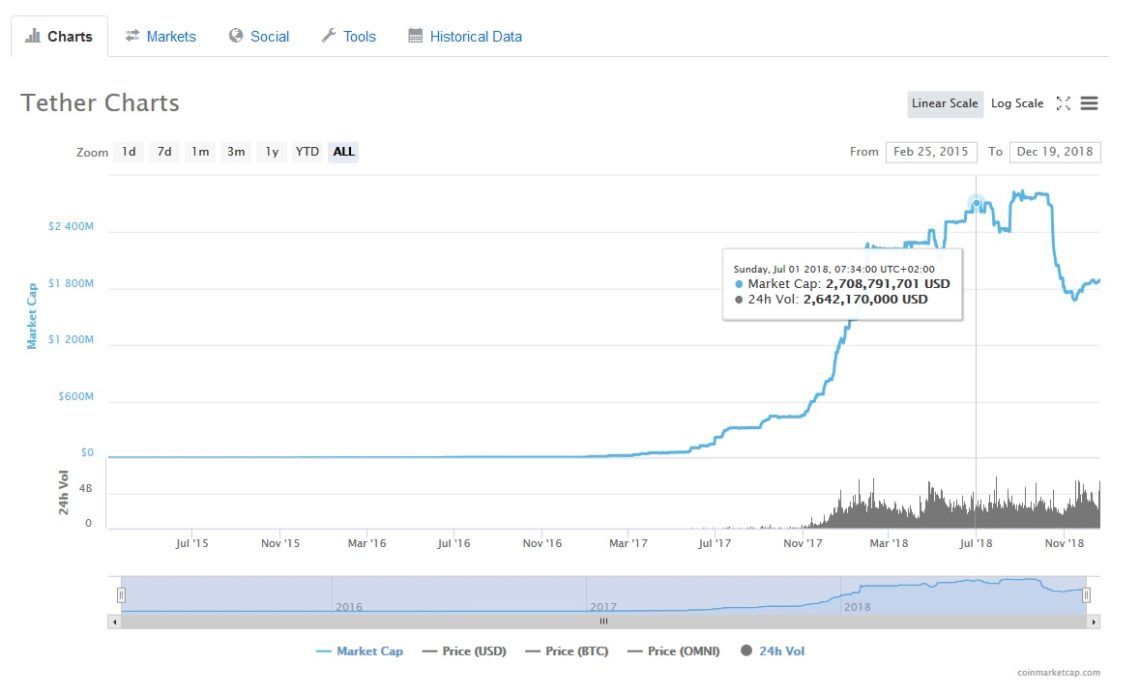Days ago, Bloomberg published a story uncovering some data about Tether and the company’s apparent solvency. Is this data reliable and does it actually prove anything?
The crypto community can finally breathe out in relief after many months of holding their collective breath due to Tether uncertainty. An article uncovered some ‘clues’ suggesting the dollar-pegging cryptocurrency actually has the USDT billions covered.
Are the clues enough though to make us believe Tether is 100% solvent?
SponsoredClues? What Clues?
The article in question is based on four bank statements from the company’s former financial partner Noble Bank Ltd. in Puerto Rico: two from 2017 (September and October) and two from the first half of this year (January and July). This alone raises a red flag.
Yet, this has to mean something, right?
Obviously, the ‘clues’ show Tether Ltd. had the funds to back their OMNI-based USDT in two of those days (sort of). On September 1, 2017, the company had $0 on its Noble Bank account, but that’s understandable: the stablecoin had just commenced its partnership with the Puerto Rico-based bank. 30 days later, $392 million were in the account. For the numbers to actually match — the USDT market cap on that day was over $436 million — Bloomberg casually added some $61 million representing a Bank of Montreal account of Stuart Hoegner, general counsel of Tether and Bitfinex. (Another red flag maybe? Adding the personal funds of a counsel to a company’s assets is not quite Accounting 101 but this addition covers the USDTs in circulation, without a doubt.)
Fast forward to January 31, 2018, and Tether was well covered with $2.2 billion in the Noble Bank statement. At that time, over 2.02 billion USDT were in circulation.
The last two dates presented by Bloomberg tell another interesting story. On July 1, 2018, the statement allegedly showed $1.9 billion in cash. The blockchain data, however, showed over 2.7 billion USDT in circulation — an $800 million difference.
Sponsored SponsoredOn July 30, the account shrunk to $210 million as Tether changed its banking partner. We can assume the movement of funds started earlier than July 1, thus the $800 million ‘missing’ might have been transferred from Noble Bank to Deltec Bank & Trust Ltd. in June.
Unfortunately, if we do that (assume), we are back to square one. All we have done thus far — till the Bloomberg story emerged — is assuming and the ‘clues’ presented by the media company didn’t change anything.
More Assumptions Anyone (Grinch Edition)?
In fact, it only brought more fire to the heated discussions between the crypto maximalists and the Tether investigators labeled by the cryptocurrency community as simply ‘haters.’
SponsoredPreston Byrne is such a ‘hater’ who immediately reacted to Bloomberg’s piece.
https://twitter.com/prestonjbyrne/status/1075248188871843840
Repo 105 was an accounting maneuver used by the defunct Lehman Brothers to ‘look good on paper’ even though, in reality, the long-term balance sheet looked rather grim. The company used short-term repurchase agreements to make the scheme work — sell assets to pay down debt only to repurchase those assets initially sold after the financial reporting is over.
Obviously, nobody accuses Tether Ltd. of such schemes. Byrne mentioned Repo 105 only to show a simple financial report can be ‘maneuvered’ short-term and can’t actually prove much of the company’s health long-term.
Andrew Rennhack has another interesting assumption. Since the Bloomberg story mentioned several transfers between Tether and Bitfinex, he believes USDT is actually backed by Bitfinex’s cryptocurrency holdings.
Sponsored Sponsored5/ What I've been saying for a long time now is that tether is backed by bitfinex crypto holdings. They could easily hand over their cold wallet keys to Noble bank for one day and get a one day line of credit deposited to the bank account.
— Andrew (@andr3w321) December 18, 2018
Rennhack is quite sure we won’t see any other financial reports or ‘clues’ from the last six months. Since the value of all cryptocurrencies collapsed, Tether and Bitfinex can’t quite make loans to justify the market cap of almost $1.9 billion in USDT.
An Audit Is In Place, Tether!
All in all, Bloomberg story or not, we don’t know anything new or significant to shed light on Tether’s financial status. Only an audit can silence the crypto ‘haters’ once and for all and calm the investors who still flinch when they hear or read about the most notorious stablecoin of them all.
Newer stablecoins like USDC and Paxos Standard showed full transparency is possible, with auditing/accounting reports made public every month. Can’t Tether just do the same?
What do you think about Bloomberg’s story? Does it shed light on the Tether matter? When will we see a proper audit and not just some random financial data? Please let us know your thoughts in the comments below.



